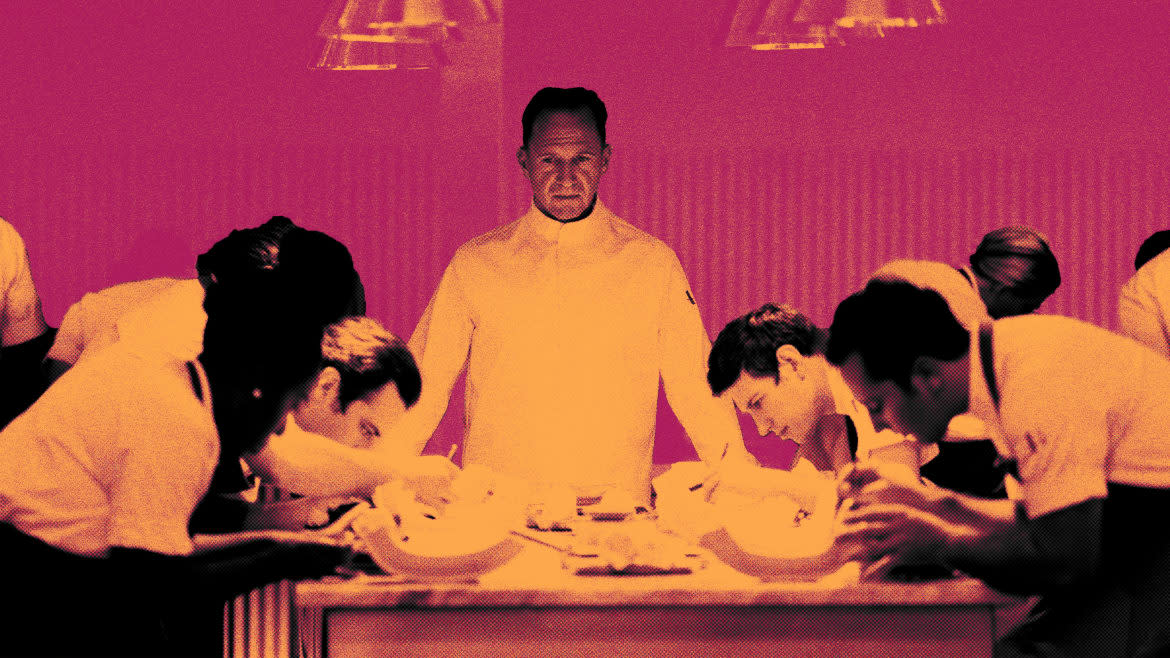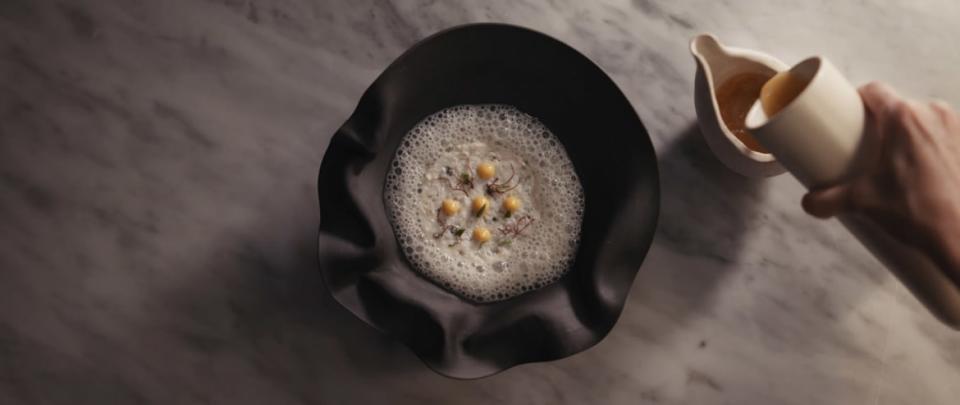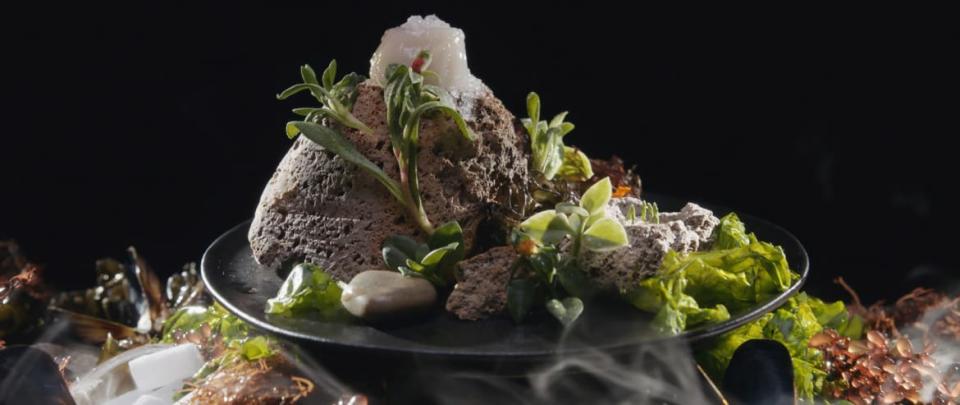Yes, ‘The Menu’ Is Based on Real (and Way Less Life-Threatening) Restaurants

Want to dine at Hawthorne, the restaurant featured in the new psychological thriller The Menu? If, after seeing the many terrors Chef Slowik (Ralph Fiennes) puts his guests through in the film, you still want to dine on the private island, good news! Although Hawthorne doesn’t exist in our real world, its pretentious finger food was based on a spread of different locations.
Spread out across the world, from the grassy hills of Scandinavia to the slushy streets of Chicago, the restaurants that inspired The Menu prove that writers Will Tracy and Seth Reiss are authentic foodies. They have Resy app notifications on for the biggest, most Michelin-starred spots in the world. If Hawthorne was a real place, they probably would’ve trekked out to the remote location to meet Chef Slowik and his team of top-notch chefs.
Hopefully, though, it wouldn’t have been on the same night as The Menu takes place—aka, the night Chef decides to shut the whole place down by killing everyone inside. That’s not a spoiler, by the way: He tells everyone, including our main characters Tyler (Nicholas Hoult) and his date Margot (Anya Taylor-Joy), this as they’re crunching on appetizers. Dinner and a show!
‘The Menu’: Eating at a Restaurant Has Never Been More Horrifying
We recommend skipping the torture of a meal at Hawthorne—Panera always has a calm panini and soup via its “You Pick Two” deal available. But The Menu is an unskippable triumph, featuring a fully realized tasting menu you’d likely find at an eatery decorated with Michelin stars. But maybe without the blood, the murder, and the screams echoing throughout an empty forest miles away from the rest of civilization.
Reiss and Tracy, who worked together at The Onion before co-writing The Menu, sat down with The Daily Beast’s Obsessed to chat about conceptualizing the tasting menu, how to prepare the dishes in your own kitchen, and Ralph Fiennes writing his own monologues.
Tell me about your own worst restaurant experiences.
Will Tracy: I can name names here, because it’s a restaurant that’s no longer around. Also, I can qualify it by saying that I ate at this restaurant twice, and the first time I went, it was excellent. Then, the second time I went, it wasn’t. I went to a place in Chicago called Graham Elliot—he’s now rightly become a food celebrity. It just goes to show you how difficult it is to maintain consistency. I remember sensing that they were having a tough night, and feeling some degree of, “That’s probably not fun in there right now. They’ll probably have their shit together next week.” It’s fuckin’ hard to put out that kind of food at that level, at that consistency, for that many people and that many covers. I always try to have some empathy for that situation.
Seth Reiss: I’m not going to name the place, because it’s still open. Also, I’m going to sound like a real asshole when I say it’s in Paris. But I will say this: It’s always recommended. It’s a tasting menu. I’ve gone twice now, because I was like, “Maybe the first time, I was wrong.” Have you had that moment where you’re eating with people and you’re at a very good place, and you try to convince yourself and those around you, This is good, right? We’re happy? We’re all happy, right? But you kind of know that it’s not? I’ve had the same thing happen to me twice at this place, and now I’m out completely.
The other one is: any time you bite into any kind of chicken sandwich at any fast food establishment, when the chicken is not good.
Tracy: The rubbery consistency.
Reiss: UGH! That is my nightmare. I would rather eat at this other place in Paris over and over and over again instead of biting into chicken like that.
Tracy: My sandwich nightmare is wet bread. It makes my stomach turn. I actually like a very dry sandwich with very little sauce.
Was there a specific restaurant that inspired The Menu?
Tracy: It’s a collection [of places]. We did start with a restaurant on an island in Scandinavia that I went to, where you’re there for four hours, and they’re serving you a bunch of food and they give you a tour of the island. Everything’s hyperlocal from the shore. But that was really just a starting point of a location for a story, and also a feeling of, What if you’re at a long dinner on an island and you feel trapped and can’t leave? From there, though, Seth and I pulled a lot of other sources and ideas. It has a little bit of the modernist style of Alinea or the former El Bulli. It has that hyper-localized, foraged thing that Noma and Stone Barns have.

Reiss: There’s this restaurant in Chicago—it’s a Michelin star restaurant called EL Ideas. Do you know it?
I’m actually from Chicago, so yes, I’ve heard of a few of these places.
Reiss: Great, great! Will and I went to some pretty great places when we were in Chicago. It’s an amazing place to eat food. The chef [at EL Ideas], his name is Phillip Foss. It’s a warmer feel inside there, and Phillip Foss is a nice man. He’s not like Chef Slowik. But it’s a similar amount of diners, and then the chef—either he, himself, or one of the sous chefs—comes to introduce each dish. He got in touch with us because he just wanted to hang out at The Onion to see how The Onion was put together.
Tracy: Although it’s different, one part of his restaurant is very good for our story, which is what Seth said—the idea of the chef coming out and explaining the dishes. Usually, you don’t hear from your chefs. But if this movie’s set in a restaurant, we want to hear from our chef. We want our chef to be directly interacting with the diners. To use that structure that EL Ideas had for our movie was great, because you get a Ralph Fiennes monologue every 10 minutes.
In ‘Straight Line Crazy,’ Ralph Fiennes Turns ‘Master Builder’ Robert Moses Into a Big Bore
How did you conceptualize the courses in the movie?
Tracy: We started with character, really, before trying to web a food concept. For instance, the first main course is the island course, where there’s a rock with foraged plants from the island. Chef gives a monologue about the island—a character in the film—and also about the relationship between the kitchen and the surrounding nature, [and] what human beings and our manipulation of nature means in that process. The chilling little bit that you get in there is that it seems as though this man has come to a place where the worth of human life has become quite devalued, to him. At the same time, you can listen to that monologue and think as Tyler does—there’s something quite beautiful, to feel small in the vastness of nature. But there’s also a hint of menace. That’s just one example, but every course does something to further our knowledge of the characters, either the chef or the people in the dining room.
Did you actually get to eat anything on the menu?
Both: NO! [Laugh]
Reiss: But it was good food. All that food was real.
Tracy: We didn’t get to eat any of it.
Reiss: When Nick Hoult was eating the filet, and he got to eat chunk after chunk—that might be our favorite dish to eat on the menu. I did poke around, at one point, maybe hoping someone would be like, “Hey, wanna try?” Nope! Never happened.
Tracy: It was a tricky thing, where the actors got to eat too much food. They had to keep eating it, because we did take after take after take. And then we get nothing.
Reiss: Will and I have an ongoing joke, and I’ve shared this with Nicholas Hoult. After this movie comes out, if it’s anything, Nicholas Hoult will be able to get a great table at any restaurant at any time he wants at any moment.
Tracy: They’ll make a special course designed for him from the film!

Reiss: And Will and I will still be setting Resy notifications for primetime. But we’ll settle for the 10:30 slot.
What would be the hardest dish to make on the menu?
Tracy: It depends on what you mean by difficult. There are some that require unusual technology. The taco course, because it requires a laser-engraver for the tortillas, is probably the most difficult in terms of resources. In terms of technique, because the flavors are unusual and subtle, the “Man’s Folly” course that sous chef Katherine (Christina Brucato) prepares is probably the most difficult to pull off.
What was the most difficult course for the two of you to conceptualize?
Reiss: It wasn’t necessarily difficult, but we always had the idea of what we wanted the ending to be—that it was s’mores. But for a script that’s pretty written, we oddly underwrote that part. Ralph’s character didn’t have a final monologue about the dish. He’s not a selfish actor by any stretch of the imagination, but he was like, “It seems like we should say goodbye in some way.” He actually wrote to us basically the monologue that he says. It was pretty letter-perfect. We tweaked a little, but we just put it in.
Tracy: It’s funny—you can be so careful spending months on what the story has to be and how to tell it. We missed an obvious thing. Obviously, the whole night is about this chef’s monumental ego, and this is the final course of his life. Of course it should be a bigger moment.
If someone was planning on making the courses in The Menu, what advice would you give them?
Tracy: I hope somebody does this and I’m invited, so I can finally eat it. I would say there’s not as many courses as you think. It’s not as long as other tasting menus. It’s somewhere in the realm of six, seven, eight courses. Some tasting menus are 20 or 30 [dishes] with tiny bites. The recommendation would be: Be aware of your portions. You don’t want your diners to leave hungry, but you also don’t want them to be full of food that’s too rich before the menu is complete.
Reiss: My advice would be to watch the movie six, seven, eight, nine times in the theater so you really understand it.
Tracy: [Laughs] And bring all of your friends!
Reiss: Bring your friends, so they all understand it. After the twentieth time, you’ll really feel it in your bones. Then, you make it.
Get the Daily Beast's biggest scoops and scandals delivered right to your inbox. Sign up now.
Stay informed and gain unlimited access to the Daily Beast's unmatched reporting. Subscribe now.


